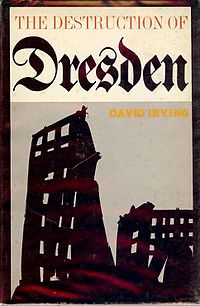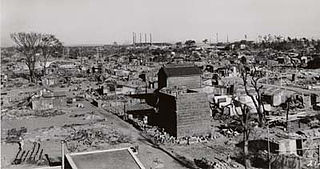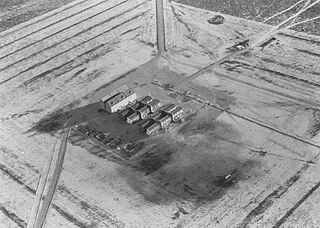 W
WFirebombing is a bombing technique designed to damage a target, generally an urban area, through the use of fire, caused by incendiary devices, rather than from the blast effect of large bombs.
 W
WThe Bombing of Aomori in World War II on July 28, 1945, was part of the strategic bombing campaign waged by the United States against military and civilian targets and population centers during the Japan home islands campaign in the closing stages of World War II.
 W
WThe Battle of Berlin was a series of attacks on Berlin by RAF Bomber Command along with raids on other German cities to keep German defences dispersed. Air Chief Marshal Sir Arthur Harris, AOC-in-C Bomber Command, believed that "We can wreck Berlin from end to end if the USAAF come in with us. It will cost us between 400 and 500 aircraft. It will cost Germany the war".
 W
WBerlin, then the capital of Nazi Germany, was subject to 363 air raids during the Second World War. It was bombed by the RAF Bomber Command between 1940 and 1945, by the USAAF Eighth Air Force between 1943 and 1945, and the French Air Force between 1944 and 1945, as part of the Allied campaign of strategic bombing of Germany. It was also attacked by aircraft of the Red Air Force, in 1941 and particularly in 1945 as Soviet forces closed on the city. British bombers dropped 45,517 tons of bombs, while American aircraft dropped 23,000 tons. As the bombings continued, more and more people fled the city. By May 1945, 1.7 million people had fled.
 W
WThe bombing of Dresden was a British-American aerial bombing attack on the city of Dresden, the capital of the German state of Saxony, during World War II. In four raids between 13 and 15 February 1945, 722 heavy bombers of the British Royal Air Force (RAF) and 527 of the United States Army Air Forces (USAAF) dropped more than 3,900 tons of high-explosive bombs and incendiary devices on the city. The bombing and the resulting firestorm destroyed more than 1,600 acres (6.5 km2) of the city centre. An estimated 22,700 to 25,000 people were killed. Three more USAAF air raids followed, two occurring on 2 March aimed at the city's railway marshalling yard and one smaller raid on 17 April aimed at industrial areas.
 W
WThe German city of Hildesheim, c. 30 kilometres south of Hanover, was the target of eight Allied air raids in 1944 and 1945 and suffered considerable bomb damage.
 W
WDuring World War II, Braunschweig was attacked by Allied aircraft in 42 bombing raids. On the night of 14/15 October 1944, the attack by No. 5 Group Royal Air Force (RAF) marked the high point of the destruction of Henry the Lion's city during the war. The air raid was part of Operation Hurricane, which was designed to demonstrate the capabilities of the Allied bombing campaign. The attack caused a massive conflagration, that might have developed into a firestorm, and resulted in Braunschweig burning continuously for two and a half days from 15 to 17 October. More than 90 percent of the medieval city centre was destroyed, changing the city's appearance to the present day.
 W
WThe Bristol Blitz was the heavy bombing of Bristol, England, by the Nazi German Luftwaffe during the Second World War. Due to the presence of Bristol Harbour and the Bristol Aeroplane Company the city was a target for bombing, and was easily found as enemy bombers were able to trace a course up the River Avon from Avonmouth using reflected moonlight on the waters into the heart of the city. Bristol was the fifth most heavily bombed British city of World War II.
 W
WThe Cardiff Blitz ; refers to the bombing of Cardiff, Wales during World War II. Between 1940 and the final raid on the city in March 1944 approximately 2,100 bombs fell, killing 355 people.
 W
WThe bombing of Chongqing, from 18 February 1938 to 23 August 1943, were massive terror bombing operations authorized by the Empire of Japan's Imperial General Headquarters and conducted by the Imperial Japanese Army Air Service (IJAAF) and Imperial Japanese Navy Air Service (IJNAF). Resistance was put up by the Chinese Air Force and the National Revolutionary Army's anti-aircraft artillery units in defense of the provisional wartime capital of Chongqing and other targets in Sichuan.
 W
WThe German city of Cologne was bombed in 262 separate air raids by the Allies during World War II, all by the Royal Air Force (RAF) but for a single failed post-capture test of a guided missile by the United States Army Air Forces. A total of 34,711 long tons of bombs were dropped on the city by the RAF. 20,000 people died during the war in Cologne due to aerial bombardments.
 W
WThe Coventry Blitz or Coventration of the city was a series of bombing raids that took place on the English city of Coventry. The city was bombed many times during the Second World War by the German Air Force (Luftwaffe). The most devastating of these attacks occurred on the evening of 14 November 1940 and continued into the morning of 15 November.
 W
WDarmstadt was bombed a number of times during World War II. The most devastating air raid on Darmstadt occurred on the night of 11/12 September 1944 when No. 5 Group of the Royal Air Force (RAF) bombed the city. 66,000 of the 110,000 inhabitants of Darmstadt at the time became homeless. Darmstadt lost between 12,500 and 13,500 inhabitants during World War II. The calligraphic memorial Darmstädter Brandnamen lists about 4,000 names. Darmstadt had several major industrial targets including Merck and Rohm and Haas chemical works as well as military communications networks.
 W
WThe Destruction of Dresden is a 1963 book by British author and Holocaust denier David Irving, in which he describes the February 1945 Allied bombing of Dresden in World War II. The book became an international best-seller during the 1960s debate about the morality of the World War II area bombing of the civilian population of Nazi Germany. The book is no longer considered to be an authoritative or reliable account of the Allied bombing and destruction of Dresden during February 1945.
 W
WDuisburg was bombed a number of times by the Allies during World War II. The most devastating air raids on Duisburg occurred during October 1944 when the city was bombed by the Royal Air Force (RAF).
 W
WGerman Village was the nickname for a range of mock houses constructed in 1943 by the U.S. Army in the Dugway Proving Ground in Utah, roughly 85 miles (137 km) southwest of Salt Lake City, in order to conduct experiments used for the bombing of Nazi Germany.
 W
WThe Bombing of Hamamatsu in World War II was part of the strategic bombing campaign waged by the United States of America against military and civilian targets and population centers of the Empire of Japan during the Japan home islands campaign in the closing states of World War II.
 W
WThe Allied bombing of Hamburg during World War II included numerous attacks on civilians and civic infrastructure. As a large city and industrial centre, Hamburg's shipyards, U-boat pens, and the Hamburg-Harburg area oil refineries were attacked throughout the war.
 W
WDuring World War II, the German city of Heilbronn was bombed numerous times by the British Royal Air Force and the United States Army Air Forces. The largest air-raid occurred on December 4, 1944, but Heilbronn was targeted several times before and after until the end of World War II. Altogether, an estimated 7,000 inhabitants of the city lost their lives during bombings.
 W
WThe Bombing of Hiratsuka in World War II was part of the strategic bombing campaign waged by the United States against military and civilian targets and population centers during the Japan home islands campaign in the closing states of World War II.
 W
WJapanese Village was the nickname for a range of houses constructed in 1943 by the U.S. Army in the Dugway Proving Ground in Utah, roughly 100 kilometers (62 mi) southwest of Salt Lake City.
 W
WThe Kassel World War II bombings were a set of Allied strategic bombing attacks which took place from February 1942 to March 1945. In a single deadliest raid on 22–23 October 1943, 150,000 inhabitants were bombed-out, at least 10,000 people died, the vast majority of the city center was destroyed, and the fire of the most severe air raid burned for seven days. The US First Army captured Kassel on 3 April 1945, where only 50,000 inhabitants remained, versus 236,000 in 1939.
 W
WThe bombing of Kobe in World War II on March 16 and 17, 1945, was part of the strategic bombing campaign waged by the United States against military and civilian targets and population centers during the Japan home islands campaign in the closing stages of World War II. The city would be bombed again in later months.
 W
WThe Bombing of Kōfu in World War II was part of the strategic bombing campaign waged by the United States against military and civilian targets and population centers of the Empire of Japan during the Japan home islands campaign in the closing states of World War II.
 W
WDuring World War II, Leipzig was repeatedly attacked by British as well as American air raids. The most severe attack was launched by the Royal Air Force in the early hours of 4 December 1943 and claimed more than 1,800 lives. Large parts of the city center were destroyed, while factories experienced temporary shortfalls in production, had to move production facilities or even were decentralized.
 W
WThe Second Great Fire of London in December 1940 was one of the most destructive air raids of the Blitz during World War II. The Luftwaffe raid caused fires over an area greater than that of the Great Fire of London in 1666, leading one American correspondent to say in a cable to his office that "The second Great Fire of London has begun". Fires started by the raid included an incendiary bomb that broke through the dome of St Paul's Cathedral, which was being guarded by a fire watch team at the behest of the Prime Minister Winston Churchill.
 W
WThe Bombing of Numazu in World War II was part of the strategic bombing campaign waged by the United States against military and civilian targets and population centers during the Japan home islands campaign in the closing stages of World War II.
 W
WThe bombing of Okazaki in World War II was part of the strategic bombing campaign waged by the United States against military and civilian targets and population centers during the Japan home islands campaign in the closing states of World War II.
 W
WThe Bombing of Sendai in World War II on July 10, 1945, was part of the strategic bombing campaign waged by the United States against the civilian population and military targets during the Japan home islands campaign in the closing stages of World War II.
 W
WThe Bombing of Shizuoka in World War II on June 19, 1945, was part of the strategic bombing campaign waged by the United States against military and civilian targets and population centers during the Japan home islands campaign in the closing stages of World War II.
 W
WThe Toyohashi Air Raid was a strategic bombing operation on the night of 19 June 1945 against the city of Toyohashi, Japan. The air raid was part of the Allies' aerial campaign against the Home Islands of the Empire of Japan during World War II.
 W
WThe Bombing of Würzburg in World War II was a large-scale air attack on the city of Würzburg, and was part of the strategic bombing campaign by the Allies against Nazi Germany. Although lacking major armaments industries and hosting around 40 hospitals at the time, Würzburg was targeted as a traffic hub and as part of the attempt by Bomber Command to break the spirit of the German people. The major raid occurred on March 16, 1945, when Royal Air Force bombers dropped incendiary bombs that set fire to much of the city, killing an estimated 5,000 people and almost completely obliterating the historic town. Almost 90% of the buildings were destroyed by a raid that lasted less than 20 minutes.